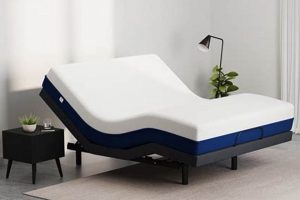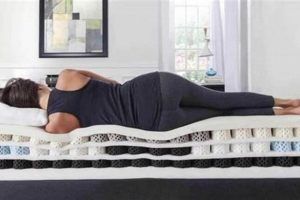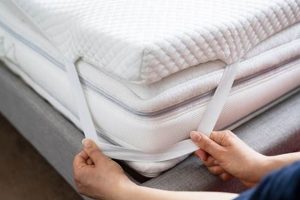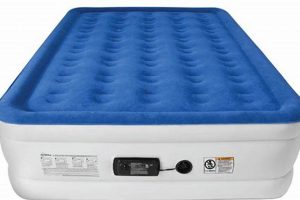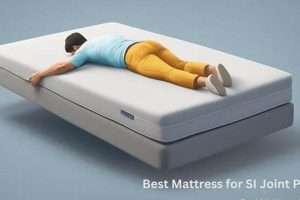Effective sanitizing solutions designed for use on bedding surfaces are formulated to eliminate bacteria, viruses, and fungi. These specialized products aim to provide a hygienic sleeping environment. An example includes a quaternary ammonium compound-based aerosol spray specifically labeled for textile applications and demonstrated to kill a wide range of pathogens upon contact with a mattress.
Maintaining a clean sleeping area contributes to overall health and well-being by reducing exposure to allergens and potential sources of infection. Historical use of sanitizing agents on mattresses dates back to times when hygiene practices were not as sophisticated, and potent chemicals were used with little understanding of long-term effects. Current formulations emphasize efficacy with a greater focus on safety and minimizing potential irritants.
The subsequent sections will delve into the essential considerations for selecting appropriate sanitizing products, including the specific criteria for evaluating effectiveness, safety profiles, and application methods. This analysis also encompasses common ingredients, potential risks, and strategies for optimal utilization to achieve desired outcomes.
Guidance on Mattress Sanitization
The following guidelines offer essential information for effectively sanitizing mattresses to promote hygiene and minimize potential health risks.
Tip 1: Identify the Need. Assess the mattress for visible stains, odors, or potential allergen presence. Regular sanitization is advisable even without obvious signs of contamination to maintain a hygienic sleeping environment.
Tip 2: Select an Appropriate Product. Prioritize solutions labeled for use on textiles or mattresses, containing ingredients demonstrated to be effective against bacteria, viruses, and fungi. Verify the product’s safety profile and ensure it meets relevant regulatory standards.
Tip 3: Conduct a Patch Test. Before applying extensively, test the solution on a small, inconspicuous area of the mattress to check for discoloration, damage, or adverse reactions. Allow the area to dry completely before proceeding.
Tip 4: Apply Evenly and Sparingly. Follow the manufacturers instructions regarding application distance and saturation. Avoid oversaturating the mattress, as excessive moisture can promote mold growth.
Tip 5: Allow Adequate Drying Time. Ensure thorough drying by ventilating the room or using a fan. Drying time can vary depending on humidity and product formulation; consult the product label for specific recommendations.
Tip 6: Address Odors Separately. If odors persist after sanitization, consider using a fabric-safe deodorizer or baking soda to absorb residual smells. Ensure the mattress is completely dry before applying additional products.
Tip 7: Protect the Mattress. Once the mattress is sanitized and dry, consider using a mattress protector to prevent future contamination and extend its lifespan.
Adherence to these recommendations will enhance the efficacy of mattress sanitization efforts, contributing to a cleaner and healthier sleep environment.
The final section will provide a summary of the information presented and offer closing remarks on mattress hygiene.
1. Efficacy
Efficacy, in the context of mattress sanitization, refers to the demonstrated ability of a disinfectant spray to eliminate or neutralize targeted microorganisms, including bacteria, viruses, and fungi, present on the mattress surface. The degree of efficacy directly determines the effectiveness of the spray in reducing the risk of infection or allergic reactions associated with these microorganisms. For instance, a spray marketed as a solution for dust mite allergens should demonstrably reduce mite populations and allergenic proteins after application. The lack of appropriate efficacy negates the product’s purpose, potentially leading to the persistence of harmful agents within the sleeping environment.
The assessment of efficacy typically involves laboratory testing against specific microorganisms relevant to mattress contamination, such as Staphylococcus aureus, Escherichia coli, and various fungal species. Test results, expressed as log reductions in microbial counts, provide quantitative data on the product’s performance. A disinfectant spray advertised for use in hospitals will require more rigorous testing and exhibit higher efficacy scores than a product intended for general household use. Real-world conditions, including the presence of organic matter and variations in application technique, can influence efficacy; therefore, testing protocols should ideally simulate these scenarios.
In conclusion, efficacy is a critical component of an effective mattress sanitizing spray. Understanding the scientific basis of efficacy and interpreting test results allows informed selection of the right disinfectant. Challenges exist in translating laboratory findings to real-world outcomes, emphasizing the need for proper application techniques and consistent product use to achieve intended levels of mattress hygiene.
2. Safety
Safety represents a paramount consideration in the selection of any sanitizing solution intended for use on mattresses. The close proximity of the sleeping surface to the human body necessitates careful evaluation of potential health risks associated with product composition and application.
- Ingredient Toxicity
The chemical constituents of a sanitizing spray must exhibit minimal toxicity to humans and pets. Ingredients known to cause respiratory irritation, skin sensitization, or other adverse health effects should be avoided. For example, some older disinfectant formulations contained high levels of volatile organic compounds (VOCs) linked to respiratory problems. Current formulations prioritize water-based or botanical ingredients with lower toxicity profiles.
- Residue Exposure
Following application, a sanitizing spray can leave residual chemicals on the mattress surface. Prolonged exposure to these residues, particularly during sleep, can pose a health risk. The ideal product leaves minimal or no residue after drying, or the residue should be composed of inert substances that pose no harm. Some sprays utilize hydrogen peroxide which breaks down into water and oxygen, thus minimizing residue concerns.
- Flammability
The flammability of a sanitizing spray is an important safety consideration, particularly in households with potential ignition sources. Alcohol-based sprays, while effective disinfectants, can pose a fire hazard if not handled with care. Non-flammable or low-flammability formulations offer a safer alternative. For instance, certain quaternary ammonium compound-based sprays are non-flammable and suitable for u
se in various environments. - Environmental Impact
Product safety extends beyond direct human health concerns to encompass environmental considerations. Sanitizing sprays containing persistent organic pollutants (POPs) or other environmentally harmful substances can contribute to ecological damage. Environmentally friendly formulations, such as those biodegradable ingredients, are preferable. The use of concentrated formulations that require dilution can also reduce packaging waste and minimize environmental impact.
In conclusion, the selection of a mattress sanitizing spray necessitates a comprehensive evaluation of its safety profile, encompassing ingredient toxicity, residue exposure, flammability, and environmental impact. Choosing products with well-documented safety data ensures effective sanitization without compromising human health or environmental sustainability.
3. Material Compatibility
The selection of a mattress sanitizing solution hinges significantly on its compatibility with the materials comprising the mattress itself. Incompatibility can lead to degradation, discoloration, or structural damage, thereby reducing the lifespan and effectiveness of the mattress. Therefore, the assessment of material compatibility is crucial in determining the most appropriate disinfectant.
- Foam Degradation
Many mattresses utilize foam, including polyurethane and memory foam. Certain chemicals present in sanitizing sprays can degrade these materials, leading to loss of support, crumbling, or reduced comfort. Strong solvents, such as bleach, can accelerate foam breakdown. Selecting a spray specifically formulated for foam mattresses minimizes this risk. An example is a spray that uses enzymes or mild detergents, proven safe for use with various foam types without causing damage.
- Fabric Discoloration and Damage
Mattress covers are often made from various fabrics, including cotton, polyester blends, and specialized performance textiles. Aggressive chemicals can cause discoloration, staining, or weakening of these fabrics. Testing a small, inconspicuous area before full application helps ascertain potential damage. A solution with a neutral pH and free from harsh dyes reduces the likelihood of fabric issues. For instance, a colorless, pH-balanced spray designed for delicate fabrics ensures the integrity of the mattress cover.
- Adhesive Breakdown
Mattresses often employ adhesives to bond layers of foam, fabric, and other components. Certain solvents can dissolve or weaken these adhesives, leading to separation and structural instability. A water-based spray with minimal solvent content is less likely to compromise adhesive integrity. A specific instance is a spray that has been tested and certified by mattress manufacturers as safe for use on mattresses constructed with common adhesives.
- Latex Sensitivity
Latex mattresses require specialized care due to the material’s inherent sensitivity to certain chemicals. Harsh chemicals can cause latex to dry out, crack, or lose its elasticity. Opting for a gentle, latex-safe spray prevents damage and prolongs the lifespan of the mattress. For instance, a spray specifically labeled as “latex-safe” ensures the material’s integrity is maintained.
The consideration of material compatibility is integral to preserving the integrity and longevity of a mattress. Choosing a sanitizing spray with a proven record of compatibility with common mattress materials is vital. Consideration of Material Compatibility ensures effective disinfection without compromising the structural soundness of the mattress.
4. Drying Time
Drying time constitutes a critical performance parameter of a mattress sanitizing solution, directly influencing both its efficacy and practicality. Prolonged dampness on a mattress creates a conducive environment for microbial proliferation, effectively negating the intended disinfectant action. Conversely, excessively rapid drying may limit the contact time between the disinfectant and microorganisms, potentially compromising the sanitization process. A best disinfectant spray for mattress needs to achieve an optimal balance, ensuring sufficient contact time for disinfection while minimizing the period of moisture retention.
The implications of drying time extend beyond microbial control to encompass user convenience and potential material damage. Extended drying periods render the mattress unusable for an extended duration, posing a significant inconvenience. More critically, prolonged moisture can foster mold growth within the mattress core, leading to long-term structural damage and potential health hazards. The ideal sanitizing spray dries quickly, minimizing downtime and mitigating the risk of mold formation. Consider a scenario where a fast-drying spray allows a hotel to sanitize mattresses between guests without disrupting room availability, or a healthcare facility that requires rapid turnaround times for patient beds.
In conclusion, drying time is an indispensable attribute of a best disinfectant spray for mattress. It directly affects antimicrobial efficacy, user convenience, and the long-term integrity of the mattress. The selection of a sanitizing spray must carefully consider drying time in relation to other performance characteristics to achieve an optimal balance between disinfection effectiveness, practicality, and material safety. A balance between drying time, material compatibility, and odor control should be maintained.
5. Odor Control
Odor control, in the context of mattress sanitization, represents a significant factor in overall satisfaction and perceived cleanliness. While disinfection targets pathogenic microorganisms, addressing unpleasant odors enhances the user experience and reinforces the impression of a thoroughly sanitized sleeping surface. The effectiveness of a sanitizing product is often judged not only by its ability to eliminate germs, but also by its capacity to neutralize or mask undesirable smells.
- Masking vs. Neutralization
Odor control mechanisms in sanitizing sprays operate via two primary strategies: masking and neutralization. Masking involves the introduction of a more potent, and ideally pleasant, scent to overwhelm the existing odor. Neutralization, conversely, aims to chemically alter the malodorous molecules, rendering them odorless. Effective odor control often combines both mechanisms to achieve comprehensive results. A spray employing masking might use a floral scent to temporarily cover the smell of mildew, while a neutralizing agent targets the underlying source of the odor for permanent removal.
- Sources of Mattress Odors
Mattress odors originate from diverse sources, including accumulated sweat, bodily fluids, mold or mildew growth, and residual smells from spills. The effectiveness of a sanitizing spray depends on its ability to address these specific odor sources. For instance, a spray designed for pet owners should effectively neutralize urine odors, whereas a spray targeting mold should contain antifungal agents to eliminate the source of the smell. Fai
lure to address the root cause of the odor often leads to its rapid reappearance, undermining the perceived efficacy of the sanitizing product. - Impact on Perceived Cleanliness
The presence of lingering odors can negatively influence the perception of cleanliness, even if the mattress has been effectively disinfected. A sanitizing spray that leaves a fresh, clean scent can enhance user satisfaction and confidence in the product’s effectiveness. Conversely, a spray with a strong, artificial fragrance may be perceived as masking underlying problems rather than truly eliminating them. Consumer preferences for scents vary widely, highlighting the importance of offering a range of fragrance options or unscented formulations.
- Long-Term Odor Prevention
Effective odor control should extend beyond immediate odor removal to include long-term prevention strategies. Some sanitizing sprays contain antimicrobial agents that inhibit the growth of odor-causing bacteria and fungi, reducing the likelihood of future odor development. Additionally, promoting proper mattress hygiene practices, such as regular vacuuming and the use of mattress protectors, can contribute to long-term odor prevention. For instance, a spray containing silver ions may provide ongoing protection against bacterial growth, reducing the need for frequent sanitization.
In summary, odor control represents a crucial aspect of mattress sanitization, influencing both user satisfaction and the perceived effectiveness of the disinfectant. Selecting a product that effectively neutralizes odors, addresses their underlying sources, and promotes long-term prevention strategies is essential for maintaining a clean, fresh-smelling sleeping environment. The best sanitizing spray will incorporate not only disinfectants but also odor-eliminating technologies to create a truly hygienic and comfortable sleep surface.
6. Residual Effects
Residual effects, in the context of mattress disinfection, refer to the lasting impact of the sanitizing solution on the treated surface following the initial application and drying phase. These effects are critical in determining the overall efficacy and safety of a mattress sanitizing spray. A product deemed the “best disinfectant spray for mattress” will exhibit desirable residual effects, such as sustained antimicrobial activity, while minimizing undesirable consequences, including chemical off-gassing or skin irritation. The presence of a persistent antimicrobial barrier on the mattress surface, for example, offers continued protection against microbial regrowth between applications, potentially reducing the frequency of sanitization needed to maintain a hygienic sleep environment. In contrast, a spray leaving behind harmful chemical residues could lead to adverse health outcomes, negating its initial disinfection benefits.
The assessment of residual effects involves evaluating several key parameters. These include the duration of antimicrobial activity, the potential for chemical migration into the mattress core, and the biocompatibility of surface residues. For instance, some sprays incorporate slow-release antimicrobial agents that gradually release over time, providing extended protection against bacteria and fungi. Others utilize volatile organic compounds (VOCs) that, while initially effective disinfectants, can off-gas for days or weeks after application, potentially causing respiratory irritation or allergic reactions. Real-world examples include healthcare facilities where mattresses must remain disinfected for extended periods between patient use, highlighting the importance of sustained antimicrobial activity, and nurseries where sensitive individuals may be exposed to mattress residues for prolonged durations, underscoring the need for biocompatible formulations.
In conclusion, residual effects represent a significant determinant of the overall suitability of a mattress sanitizing spray. A truly effective product offers sustained antimicrobial protection without compromising user safety or mattress integrity. Addressing the potential challenges associated with chemical off-gassing and skin irritation requires careful selection of ingredients and rigorous testing to ensure that the benefits of disinfection outweigh any potential adverse consequences. Understanding these elements is essential for informed decision-making in selecting a spray that delivers lasting hygiene and protects health.
Frequently Asked Questions
This section addresses common inquiries regarding the use of mattress sanitizing sprays, offering guidance to ensure effective disinfection and promote a hygienic sleep environment.
Question 1: Is frequent use of a best disinfectant spray for mattress necessary?
The frequency of mattress sanitization depends on several factors, including usage intensity, the presence of pets, and individual hygiene practices. Regular application is generally recommended for mattresses in high-traffic areas or those used by individuals with allergies. Infrequent use may suffice for mattresses in guest rooms or low-use environments.
Question 2: Can a best disinfectant spray for mattress eliminate bed bugs?
While some sprays may possess insecticidal properties, they are not a substitute for professional pest control services. Bed bug infestations require comprehensive treatment strategies beyond surface-level disinfection. Consult a qualified pest control expert for effective eradication methods.
Question 3: Will a best disinfectant spray for mattress remove stains?
Mattress sanitizing sprays primarily target microorganisms, not stains. Specialized stain removal products are necessary to address visible blemishes. Always test cleaning solutions in an inconspicuous area before applying them to the entire mattress.
Question 4: Are all best disinfectant spray for mattress safe for children and pets?
Not all formulations are created equal. Carefully review the product label to ensure the solution is safe for use around children and pets. Opt for non-toxic, hypoallergenic options whenever possible. Allow the mattress to dry completely before allowing children or pets access.
Question 5: How does one properly apply a best disinfectant spray for mattress?
Follow the manufacturer’s instructions regarding application distance, saturation levels, and drying time. Ensure adequate ventilation during and after application. Avoid oversaturating the mattress, as excessive moisture can promote mold growth.
Question 6: What is the appropriate drying time after applying a best disinfectant spray for mattress?
Drying time varies depending on the product formulation and environmental conditions. Generally, allow several hours for the mattress to dry completely. Use a fan to expedite the drying process. Avoid using the mattress until it is fully dry to prevent moisture-related issues.
Proper understanding of these FAQs and thorough research on best disinfectant spray for mattress helps choose a safe and appropriate disinfectant.
The subsequent section will provide a conclusion of mattress sanitization and best choice of disinfectant.
Conclusion
The preceding analysis has illuminated the multifaceted considerations involved in selecting a suitable mattress sanitizing spray. A product’s efficacy, safety, material compatibility, drying time, odor control capabilities, and residual effects are all crucial determinants of its overall utility and appropriateness. Effe
ctive disinfection, without compromising the integrity of the mattress or posing risks to human health, constitutes the core objective.
Prudent evaluation of the attributes discussed is essential for responsible decision-making. Consistent application of recommended hygiene practices, coupled with the informed selection of a appropriate disinfecting agent, contributes significantly to the creation and maintenance of a healthier sleeping environment. Continued vigilance in monitoring product advancements and emerging research remains imperative for optimizing mattress hygiene strategies.


![Top-Rated Best Mattress for Pack N Play - [Year] Review Organic & Natural Mattress Buyer’s Guide: Non-Toxic Sleep Solutions Top-Rated Best Mattress for Pack N Play - [Year] Review | Organic & Natural Mattress Buyer’s Guide: Non-Toxic Sleep Solutions](https://mattressworldpa.com/wp-content/uploads/2025/07/th-7612-300x200.jpg)
